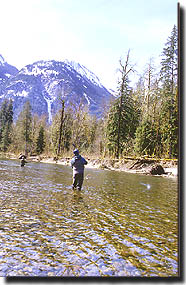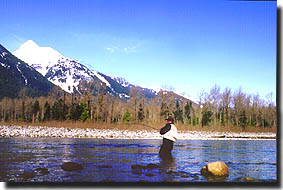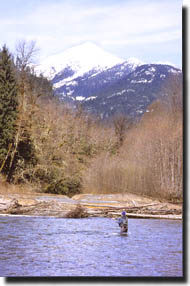
Driving thru parts of the Pemberton Valley
Squamish River, BC
by Ian Forbes
Fifty kilometers north of Vancouver, British Columbia, at the head of scenic Howe Sound is the Squamish River System.
 This
large glacier fed stream is home to late running winter steelhead
and four species of Pacific Salmon:
Chinook,
coho,
chum and
pinks. There are resident and sea running
Dolly Varden,
cutthroat trout and a few
rainbow trout. The Squamish has four main tributaries: the Elaho,
the Ashlu, the Cheakamus and the Mamquam. Each has its own unique
eco-system. There are also many creeks feeding the Squamish River.
Each offers a rearing ground for young salmonids.
This
large glacier fed stream is home to late running winter steelhead
and four species of Pacific Salmon:
Chinook,
coho,
chum and
pinks. There are resident and sea running
Dolly Varden,
cutthroat trout and a few
rainbow trout. The Squamish has four main tributaries: the Elaho,
the Ashlu, the Cheakamus and the Mamquam. Each has its own unique
eco-system. There are also many creeks feeding the Squamish River.
Each offers a rearing ground for young salmonids.
Extensive logging severely affected the spawning beds of salmonids in the Squamish Valley. Mature trees act as reservoirs, holding back excess water and releasing it slowly. Stripping the large trees from the precipitous slopes of the Squamish Valley caused flash floods which wiped out the limited spawning areas of the small tributaries. Shovelnose Creek is a good example. It is an important spawning tributary for the Squamish River. The lower portion of the creek had a good insect population and it's a vital nursery for young salmonids. A number of years ago a flood blasted a new path in the valley bottom and destroyed the lower reaches of Shovelnose Creek. Fortunately, recent stream re-habilitation has improved this disaster.
Commercial fishing and native gill nets in the river were also contributing factors to the downturn in salmonid numbers. Angling hasn't been to blame. Long before salmon and steelhead numbers crashed, sport fisherman were voluntarily releasing their fish.
 Despite the abuses of man the Squamish continues to offer fair fishing.
Work has been done on salmon enhancement in all small creeks of
the Squamish Valley. Building the Tenderfoot hatchery and spawning
channels on the Cheakamus River have enhanced it's diminished wild
stock. The dam on the upper Cheakamus River has kept that stream
with a more stable flow. Vital steelhead spawning areas have been
closed to fishing and all wild steelhead must be released. A bait
ban has protected dour steelhead who are beginning to prepare for
spawning.
Despite the abuses of man the Squamish continues to offer fair fishing.
Work has been done on salmon enhancement in all small creeks of
the Squamish Valley. Building the Tenderfoot hatchery and spawning
channels on the Cheakamus River have enhanced it's diminished wild
stock. The dam on the upper Cheakamus River has kept that stream
with a more stable flow. Vital steelhead spawning areas have been
closed to fishing and all wild steelhead must be released. A bait
ban has protected dour steelhead who are beginning to prepare for
spawning.
|
River
Guides on the Squamish River
|
 A short distance above the entrance of the Cheakamus, the Squamish
River changes from gravel and rock filled runs to a meandering sandy
bottom river without many of the classic holding pools. This section
of river is filled with sweepers and buried logs. This type of water
continues upstream for almost 20 kilometers from the Cheakamus River
Bridge. Fortunately, this is also one of the few portions with limited
access to the river. The land is mostly private and there is a large
Native Reserve in the valley.
A short distance above the entrance of the Cheakamus, the Squamish
River changes from gravel and rock filled runs to a meandering sandy
bottom river without many of the classic holding pools. This section
of river is filled with sweepers and buried logs. This type of water
continues upstream for almost 20 kilometers from the Cheakamus River
Bridge. Fortunately, this is also one of the few portions with limited
access to the river. The land is mostly private and there is a large
Native Reserve in the valley.
18 kilometers above the Cheakamus River Bridge the paved road ends and the Squamish River changes back to the fast gravelly runs that all steelheaders admire. The logging road follows the Squamish upstream for another 40 kilometers and is seldom out of sight of the river. There are numerous access points for anglers, rafters, campers or sightseers. It is a very scenic valley. Snow covered peaks rise abruptly from the valley bottom and a few hanging valleys have year-round glaciers. Blacktail deer and black bear frequent the valley bottom. Mountain goats can often be seen climbing the precipitous cliffs. And, although rare, grizzly bears are infrequent visitors. Even moose are present in the upper valley.
Cheakamus River and dam



No comments:
Post a Comment